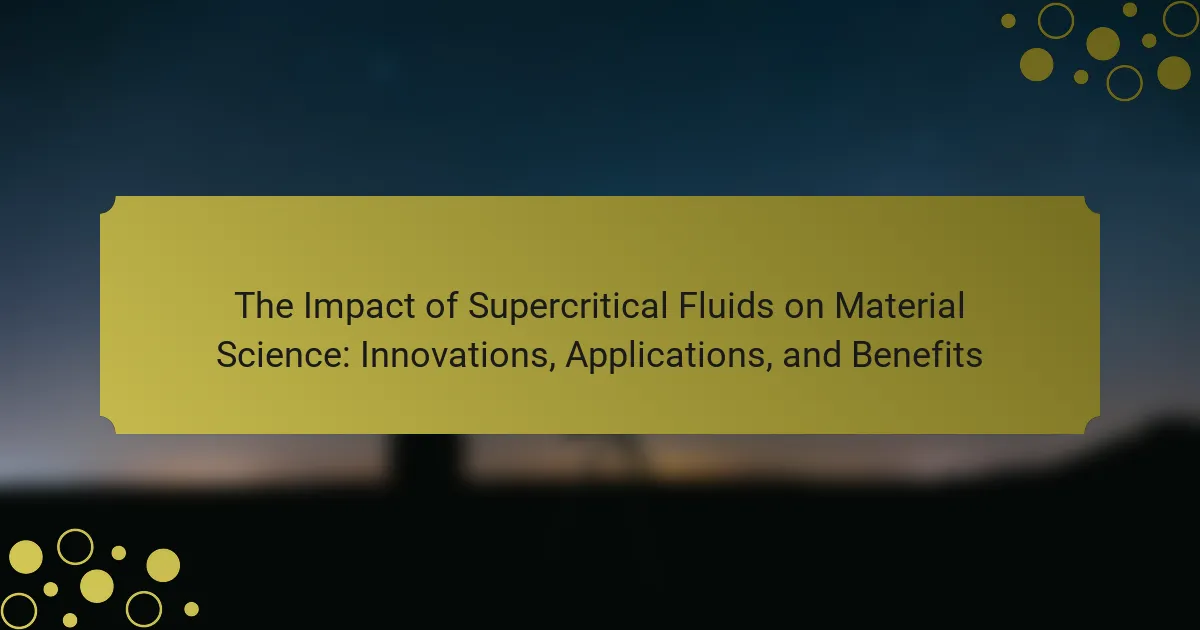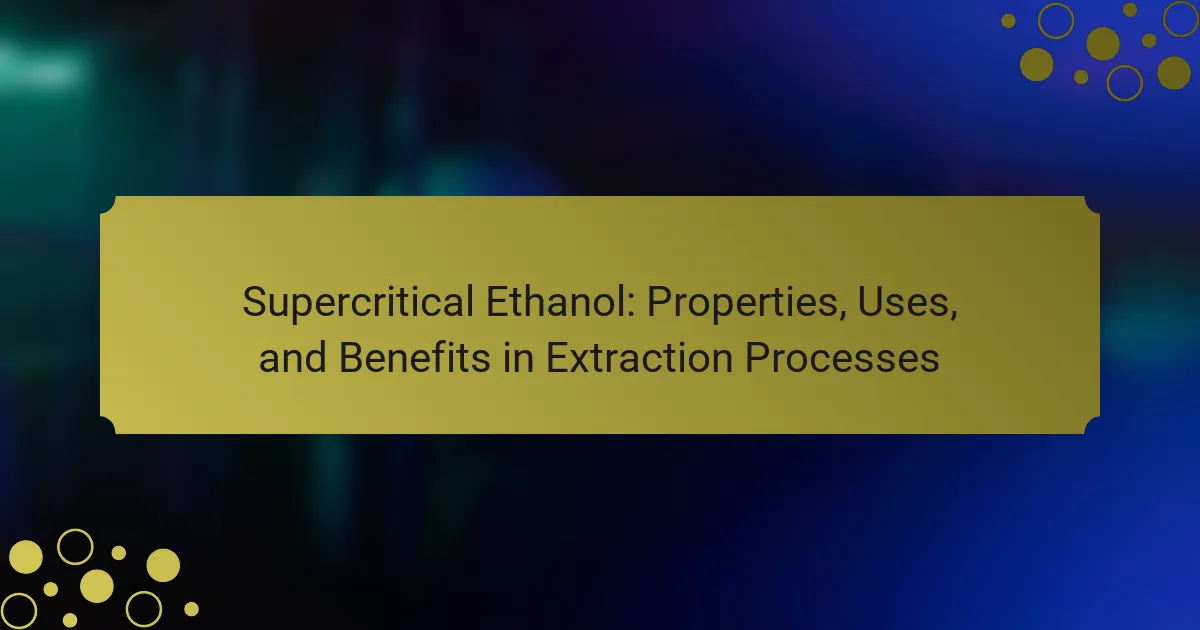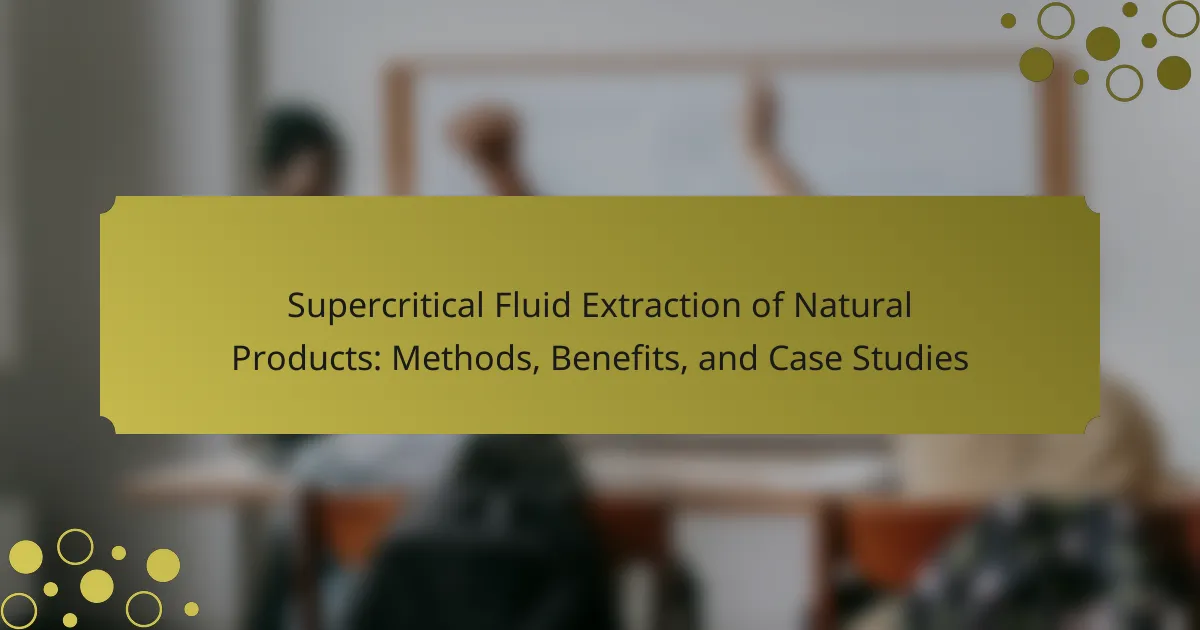Supercritical Fluid Chromatography (SFC) is a separation technique that utilizes supercritical fluids as the mobile phase, combining the properties of gases and liquids for enhanced solubility and diffusion. This method is particularly effective for separating non-volatile and thermally sensitive compounds, offering faster analysis times, high resolution, and sensitivity for complex mixtures. SFC finds applications across various fields, including pharmaceuticals for purifying active ingredients, food science for analyzing flavors, and environmental monitoring for detecting pollutants. The technique commonly employs carbon dioxide due to its low toxicity and ease of removal, making it an environmentally friendly and cost-effective option in analytical chemistry.
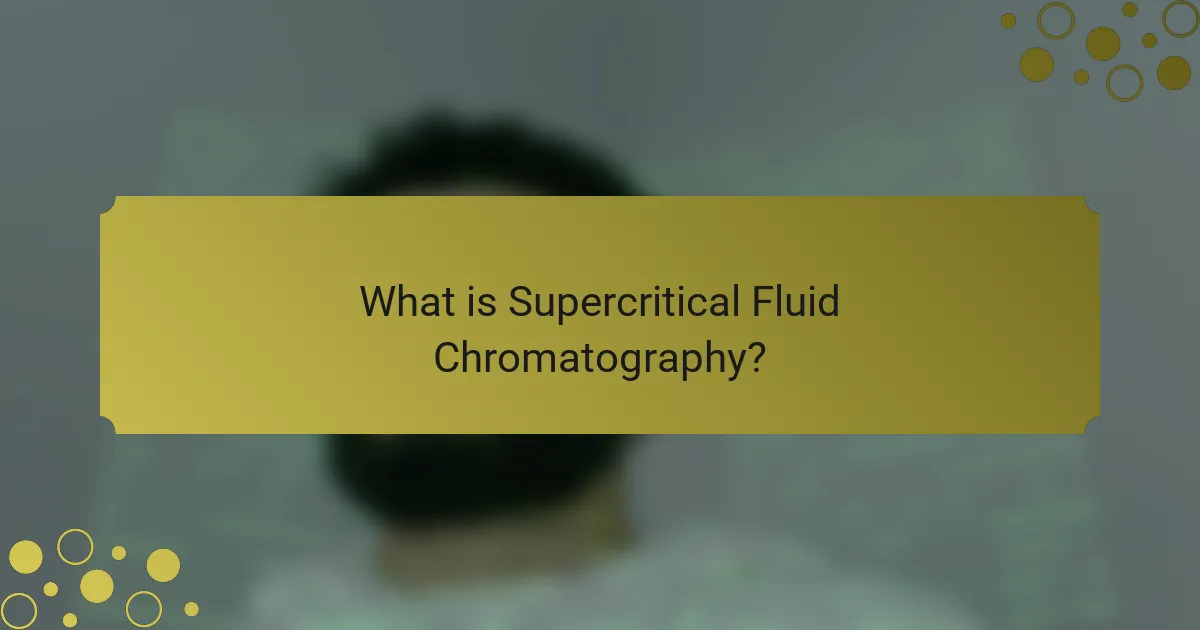
What is Supercritical Fluid Chromatography?
Supercritical Fluid Chromatography (SFC) is a separation technique that uses supercritical fluids as the mobile phase. Supercritical fluids possess properties of both gases and liquids, allowing for enhanced solubility and diffusion. This method is particularly effective for separating non-volatile and thermally sensitive compounds. SFC can achieve faster analysis times compared to traditional liquid chromatography. It also offers high resolution and sensitivity for complex mixtures. SFC is widely used in pharmaceuticals, environmental analysis, and food chemistry. The technique utilizes carbon dioxide as a common supercritical fluid due to its low toxicity and easy removal from products.
How does Supercritical Fluid Chromatography work?
Supercritical Fluid Chromatography (SFC) works by utilizing a supercritical fluid as the mobile phase for separation. A supercritical fluid is a substance at a temperature and pressure above its critical point, where it exhibits properties of both liquids and gases. In SFC, carbon dioxide is commonly used due to its low viscosity and high diffusivity. The sample is injected into a column packed with stationary phase material. The supercritical fluid carries the sample through the column. As the sample interacts with the stationary phase, different components are separated based on their affinities. The separated components are then detected, often using UV or mass spectrometry. This method provides rapid analysis and high-resolution separations. SFC is particularly effective for analyzing thermally unstable compounds.
What are the key components of Supercritical Fluid Chromatography?
The key components of Supercritical Fluid Chromatography (SFC) include the supercritical fluid, a high-pressure pump, an injection system, a chromatographic column, a detector, and a data acquisition system. The supercritical fluid, often carbon dioxide, serves as the mobile phase. A high-pressure pump generates the necessary pressure to maintain the fluid in a supercritical state. The injection system introduces the sample into the mobile phase. The chromatographic column facilitates the separation of compounds based on their interactions with the stationary phase. A detector measures the separated components as they elute from the column. Finally, the data acquisition system records and analyzes the detector signals. These components work together to achieve effective separation and analysis of complex mixtures.
How does pressure and temperature influence Supercritical Fluid Chromatography?
Pressure and temperature significantly influence Supercritical Fluid Chromatography (SFC). The solubility of analytes in the supercritical fluid changes with both factors. Increased pressure raises the density of the supercritical fluid, enhancing its solvent power. Higher temperatures can decrease the viscosity of the fluid, allowing for faster mass transfer.
These changes can lead to improved separation efficiency and resolution of compounds. Research indicates that optimal conditions for SFC commonly range from 100 to 300 bar in pressure and 30 to 60 degrees Celsius in temperature. Adjusting these parameters allows for the fine-tuning of retention times and selectivity for target compounds.
What are the main techniques used in Supercritical Fluid Chromatography?
The main techniques used in Supercritical Fluid Chromatography (SFC) include gradient elution, isocratic elution, and backpressure modulation. Gradient elution involves changing the composition of the mobile phase during the separation process. This technique enhances the resolution of closely eluting compounds. Isocratic elution maintains a constant mobile phase composition throughout the separation. It is often simpler and quicker for less complex mixtures. Backpressure modulation allows for the adjustment of pressure in the system. This technique can improve separation efficiency and peak shape. Each of these techniques contributes to the versatility and effectiveness of SFC in various applications.
What distinguishes Supercritical Fluid Chromatography from other chromatographic techniques?
Supercritical Fluid Chromatography (SFC) is distinguished by its use of supercritical fluids as the mobile phase. Supercritical fluids, such as carbon dioxide, possess unique properties that enhance separation efficiency. They combine the characteristics of gases and liquids, allowing for better solubility and faster mass transfer. This results in shorter analysis times compared to traditional liquid chromatography. SFC also offers lower viscosity, which reduces back pressure and increases column lifespan. Additionally, it is more environmentally friendly due to the use of non-toxic solvents. These attributes make SFC particularly suitable for the separation of thermally sensitive compounds.
How is the mobile phase selected in Supercritical Fluid Chromatography?
The mobile phase in Supercritical Fluid Chromatography (SFC) is primarily selected based on the solubility of the analytes. Supercritical fluids, commonly carbon dioxide, are chosen for their unique properties. The selection also considers the polarity of the analytes and the stationary phase used. Analytes with higher polarity may require modifiers like alcohols or ethers to enhance solubility. Temperature and pressure adjustments can further optimize the mobile phase’s effectiveness. The ability to fine-tune these parameters provides flexibility in method development. This approach ensures efficient separation and analysis of diverse compounds.
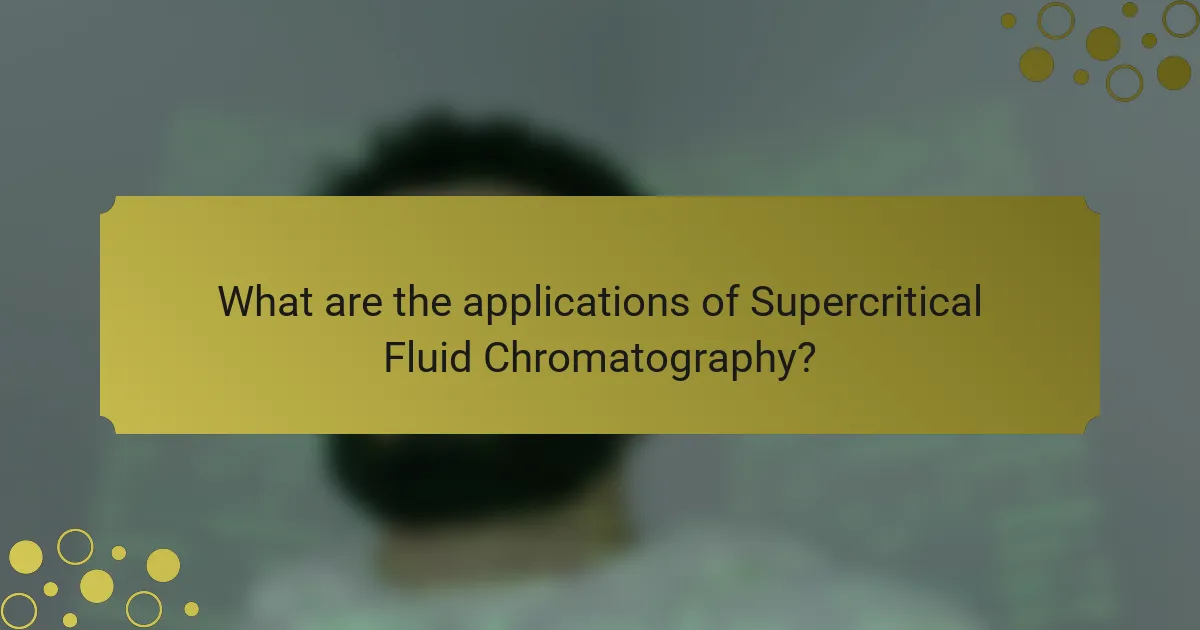
What are the applications of Supercritical Fluid Chromatography?
Supercritical Fluid Chromatography (SFC) is widely used for the separation and analysis of compounds. Its applications include pharmaceutical analysis, where it helps in the purification of active pharmaceutical ingredients. In food science, SFC is employed to analyze flavors and fragrances efficiently. Environmental monitoring utilizes SFC for detecting pollutants in various matrices. Additionally, SFC is beneficial in the petrochemical industry for separating hydrocarbons. Its ability to use supercritical CO2 as a solvent enhances its effectiveness in these applications. Studies have shown that SFC offers faster analysis times compared to traditional methods.
In which industries is Supercritical Fluid Chromatography primarily utilized?
Supercritical Fluid Chromatography (SFC) is primarily utilized in the pharmaceutical, food and beverage, and environmental industries. In the pharmaceutical industry, SFC is used for the purification and analysis of chiral compounds. This technique enhances efficiency and reduces solvent usage compared to traditional methods. In the food and beverage sector, SFC is applied for extracting flavors and essential oils. It offers a cleaner extraction process, preserving the integrity of the compounds. Additionally, in environmental applications, SFC is utilized for analyzing pollutants in samples. Its sensitivity allows for the detection of trace levels of contaminants. These industries benefit from SFC’s ability to provide high-resolution separations and reduced environmental impact.
How does Supercritical Fluid Chromatography benefit the pharmaceutical industry?
Supercritical Fluid Chromatography (SFC) benefits the pharmaceutical industry by enhancing separation efficiency and reducing solvent usage. It allows for rapid analysis of complex drug formulations. SFC utilizes supercritical fluids, which have unique properties that improve mass transfer rates. This leads to faster separation times compared to traditional liquid chromatography.
Additionally, SFC can handle a wide range of polar and non-polar compounds effectively. It offers high resolution and sensitivity, crucial for detecting impurities in pharmaceuticals. The reduced environmental impact is another advantage, as SFC minimizes hazardous waste generation. Overall, these benefits contribute to more efficient drug development processes.
What role does Supercritical Fluid Chromatography play in environmental analysis?
Supercritical Fluid Chromatography (SFC) plays a crucial role in environmental analysis by providing efficient separation and analysis of complex mixtures. SFC utilizes supercritical fluids, typically carbon dioxide, as a mobile phase. This method is particularly effective for analyzing environmental pollutants, such as pesticides and heavy metals. Studies have shown that SFC offers higher resolution and faster analysis times compared to traditional methods. Additionally, SFC is environmentally friendly due to its reduced solvent usage. The technique is also capable of analyzing thermally labile compounds without degradation. Overall, SFC enhances the capability of environmental laboratories to monitor and assess contamination levels accurately.
What types of samples can be analyzed using Supercritical Fluid Chromatography?
Supercritical Fluid Chromatography (SFC) can analyze a variety of sample types. These include polar and non-polar compounds. SFC is particularly effective for separating chiral compounds. It can also analyze pharmaceuticals, natural products, and environmental samples. Additionally, SFC is used for food and beverage analysis. Its ability to handle complex matrices is a key advantage. The method provides high resolution and fast analysis times. This versatility makes SFC suitable for many industries.
How does Supercritical Fluid Chromatography handle complex matrices?
Supercritical Fluid Chromatography (SFC) effectively handles complex matrices by utilizing supercritical fluids as mobile phases. These fluids possess unique properties that enhance solubility and selectivity. The low viscosity of supercritical fluids allows for faster mass transfer, improving separation efficiency. Additionally, SFC can be finely tuned by adjusting temperature and pressure, providing flexibility in method development.
SFC is particularly adept at separating compounds in complex mixtures, such as those found in pharmaceuticals and environmental samples. The technique minimizes sample preparation steps, preserving the integrity of sensitive compounds. Studies show that SFC can resolve closely related compounds that traditional methods struggle with. This capability is supported by its ability to achieve high-resolution separations, as demonstrated in research by K. H. W. Lam and colleagues in “Supercritical Fluid Chromatography: A Review” published in 2020.
What is the effectiveness of Supercritical Fluid Chromatography for volatile compounds?
Supercritical Fluid Chromatography (SFC) is highly effective for separating volatile compounds. SFC utilizes supercritical fluids, often carbon dioxide, as mobile phases. This method enhances the solubility of volatile compounds. It provides faster analysis times compared to traditional methods like gas chromatography. SFC also reduces solvent consumption, making it more environmentally friendly. Studies show that SFC can achieve high resolution and sensitivity for volatile analytes. For instance, research has demonstrated its ability to separate complex mixtures efficiently. Overall, SFC is a powerful technique for analyzing volatile compounds in various applications.
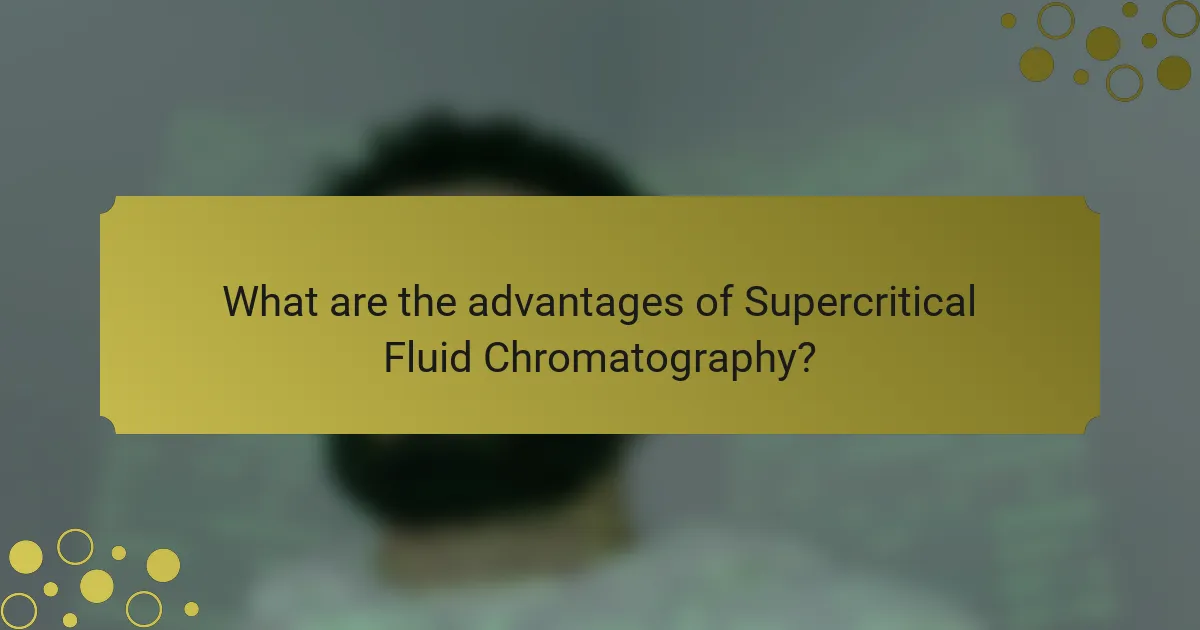
What are the advantages of Supercritical Fluid Chromatography?
Supercritical Fluid Chromatography (SFC) offers several advantages over traditional chromatographic methods. SFC provides faster separation times due to the lower viscosity of supercritical fluids compared to liquids. This results in higher efficiency and quicker analysis. Additionally, SFC utilizes less solvent, which is more environmentally friendly and cost-effective. The ability to manipulate the density of the supercritical fluid allows for greater control over the separation process. SFC is also effective for a wide range of compounds, including polar and non-polar substances. Furthermore, it can be coupled with mass spectrometry for enhanced detection capabilities. These advantages make SFC a valuable technique in analytical chemistry.
What benefits does Supercritical Fluid Chromatography offer compared to traditional methods?
Supercritical Fluid Chromatography (SFC) offers several benefits compared to traditional chromatographic methods. SFC typically provides faster separation times due to higher diffusion rates in supercritical fluids. This results in reduced analysis time and increased throughput. The use of supercritical CO2 as a mobile phase allows for lower viscosity compared to organic solvents, enhancing flow rates. SFC is also more environmentally friendly, as it often requires fewer hazardous solvents. Additionally, it can effectively separate compounds that are difficult to analyze with liquid chromatography. The ability to tune the properties of the supercritical fluid enhances selectivity and resolution. These advantages make SFC a valuable technique in various analytical applications, including pharmaceuticals and environmental analysis.
How does Supercritical Fluid Chromatography improve separation efficiency?
Supercritical Fluid Chromatography (SFC) improves separation efficiency by utilizing supercritical fluids as the mobile phase. These fluids exhibit unique properties, such as low viscosity and high diffusivity. Low viscosity allows for faster flow rates, reducing analysis time. High diffusivity enhances mass transfer, leading to sharper peaks and better resolution in chromatograms.
Additionally, SFC can adjust solvation strength by changing pressure and temperature. This flexibility enables selective interactions with analytes, further enhancing separation. Studies have shown that SFC can achieve higher resolution compared to traditional liquid chromatography. For instance, SFC can separate complex mixtures more effectively, making it suitable for various applications, including pharmaceuticals and environmental analysis.
What environmental advantages does Supercritical Fluid Chromatography provide?
Supercritical Fluid Chromatography (SFC) offers significant environmental advantages. It utilizes supercritical fluids, typically carbon dioxide, which are less toxic than traditional organic solvents. This reduces hazardous waste generation during the chromatographic process. SFC also operates at lower temperatures compared to conventional methods. Lower temperatures lead to reduced energy consumption and a smaller carbon footprint. Moreover, carbon dioxide is often sourced from recycled industrial processes, enhancing sustainability. The efficiency of SFC allows for faster separations, minimizing resource usage. These factors collectively contribute to a more environmentally friendly analytical technique.
What are the limitations of Supercritical Fluid Chromatography?
Supercritical Fluid Chromatography (SFC) has several limitations. One major limitation is the cost of equipment and solvents. SFC requires specialized instruments that can be expensive to purchase and maintain. Another limitation is the limited availability of suitable stationary phases. Not all stationary phases are compatible with supercritical fluids, which restricts method development. Additionally, SFC can have lower sensitivity compared to traditional methods like High-Performance Liquid Chromatography (HPLC). This can affect the detection of trace compounds. Temperature and pressure conditions in SFC also require careful optimization. Variations can lead to inconsistent results. Finally, SFC may not be ideal for all types of samples, particularly highly polar or ionic compounds. These limitations can impact the versatility and applicability of SFC in various analytical scenarios.
How do cost factors influence the adoption of Supercritical Fluid Chromatography?
Cost factors significantly influence the adoption of Supercritical Fluid Chromatography (SFC). High initial investment in equipment and technology can deter laboratories from adopting SFC. The cost of supercritical fluids, particularly carbon dioxide, can also affect operational expenses. Additionally, training personnel to operate SFC systems incurs further costs.
Research by the American Chemical Society indicates that laboratories often weigh these costs against the benefits of increased efficiency and resolution in separations. Cost-effectiveness becomes critical when comparing SFC to traditional methods like liquid chromatography. The long-term savings from reduced solvent usage and waste disposal can justify the initial costs.
Ultimately, cost factors shape decisions regarding the adoption of SFC in various applications, influencing the overall market growth and technology acceptance.
What challenges exist in method development for Supercritical Fluid Chromatography?
Method development for Supercritical Fluid Chromatography (SFC) faces several challenges. One significant challenge is optimizing the selection of solvents. The choice of supercritical fluids must balance solubility and selectivity. Another challenge is the need for precise temperature and pressure control. Inconsistent conditions can lead to variable results. Additionally, method robustness is a concern. Variations in sample composition can affect reproducibility. Equipment limitations also present challenges. Not all laboratories have access to advanced SFC systems. Lastly, regulatory compliance can complicate method development. Adhering to guidelines can slow the process. These challenges highlight the complexity of developing effective SFC methods.
What best practices should be followed when using Supercritical Fluid Chromatography?
Use appropriate mobile phases for Supercritical Fluid Chromatography (SFC). Common choices include carbon dioxide and modifiers like methanol or ethanol. Optimize temperature and pressure settings for the specific analysis. Maintaining consistent flow rates is crucial for reproducibility. Regularly calibrate and maintain the SFC system to ensure accuracy. Utilize suitable detectors for the compounds of interest. Implement proper sample preparation techniques to enhance separation efficiency. Follow safety protocols when handling supercritical fluids to prevent accidents.
How can one optimize conditions for Supercritical Fluid Chromatography?
To optimize conditions for Supercritical Fluid Chromatography (SFC), one must adjust parameters such as temperature, pressure, and solvent composition. Increasing temperature can enhance solubility and reduce viscosity. Adjusting pressure allows for better control of the supercritical state of the solvent. Modifying the solvent composition, including the addition of co-solvents, can improve selectivity and resolution.
These adjustments can lead to improved separation efficiency and faster analysis times. Research indicates that optimal conditions vary depending on the specific analytes and stationary phases used. For instance, studies show that using a mixture of carbon dioxide and methanol as a solvent can significantly enhance the extraction of polar compounds.
Additionally, fine-tuning the flow rate can help achieve a balance between resolution and analysis speed. Implementing these strategies ensures effective optimization of SFC conditions for various applications.
What common troubleshooting tips exist for Supercritical Fluid Chromatography?
Common troubleshooting tips for Supercritical Fluid Chromatography (SFC) include checking the system pressure, ensuring proper solvent flow, and verifying the temperature settings. Low pressure may indicate a leak or blockage in the system. If the solvent flow is inconsistent, inspect the pump and check for air bubbles. Incorrect temperature can affect separation efficiency; therefore, confirm that the temperature is set according to method requirements. Additionally, monitor the detector response for anomalies, which may signal issues with the column or mobile phase composition. Regular maintenance and calibration of equipment also help prevent common issues in SFC operations.
Supercritical Fluid Chromatography (SFC) is a separation technique utilizing supercritical fluids, primarily carbon dioxide, to enhance the analysis of non-volatile and thermally sensitive compounds. This article provides a comprehensive overview of SFC, detailing its operational principles, key components, and the influence of pressure and temperature on separation efficiency. It also explores various techniques employed in SFC, its applications across industries such as pharmaceuticals, food, and environmental analysis, and the advantages it offers over traditional chromatographic methods. Additionally, the article addresses challenges in method development and best practices for optimizing SFC conditions.

